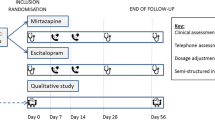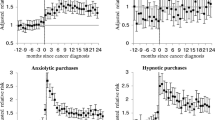Abstract
Purpose
Cancer patients are often prescribed antidepressants, but little data is available about whether the type and dose are similar to prescriptions to patients with other chronic diseases. This study compared the prescription practices of antidepressants to cancer and non-cancer inpatients at a major Australian tertiary hospital and assessed side effects and potential drug-drug interactions.
Methods
Inpatients diagnosed with cancer within the past 12 months and prescribed antidepressants were age and gender matched to inpatients with other chronic disease conditions. Data from 75 cancer and 75 non-cancer inpatients were extracted.
Results
Antidepressants were prescribed to cancer and non-cancer patients, respectively, for the treatment of depression (n = 50 vs n = 59), other mental health problems (n = 8 vs n = 11, p < 0.67) or unspecified reasons (n = 17 vs n = 5, p < 0.02). Mirtazapine (n = 11/75) was most commonly prescribed to cancer patients followed by duloxetine (n = 9/75). Desvenlafaxine (n = 15/75) was prescribed most commonly to non-cancer inpatients, followed by mirtazapine (n = 11/75). Four cancer patients and three non-cancer patients had documented adverse side effects from antidepressants. About one-third of cancer patients (n = 23/75) and about a quarter of non-cancer patients (n = 18/75) were prescribed other medicines with the potential for drug-drug interactions with antidepressants.
Conclusions
Antidepressants were prescribed for a range of indications in all patients, but more commonly for unspecified reasons among the cancer patients. Future prospective studies that monitor antidepressant prescribing to cancer patients should ascertain details of the indication, pathways to prescription and differences in type, dose or schedule depending on prescribing medical practitioner.

Similar content being viewed by others
References
GBD 2013 Mortality and Causes of Death Collaborators (2015) Global, regional, and national age-sex specific all-cause and cause-specific mortality for 240 causes of death, 1990–2013: a systematic analysis for the Global Burden of Disease Study 2013. Lancet 385:117–171
Hert M, Correll CU, Bobes J et al (2011) Physical illness in patients with severe mental disorders. I. Prevalence, impact of medications and disparities in health care. World Psychiatry 10:52–77
Stafford L, Judd F, Gibson P, Komiti A, Mann GB, Quinn M (2015) Anxiety and depression symptoms in the 2 years following diagnosis of breast or gynaecologic cancer: prevalence, course and determinants of outcome. Support Care Cancer 23:2215–2224
Gallagher J, Parle M, Cairns D (2002) Appraisal and psychological distress six months after diagnosis of breast cancer. Br J Health Psychol 7:365–376
Neilson KA, Pollard AC, Boonzaier AM et al (2010) Psychological distress (depression and anxiety) in people with head and neck cancers. Med J Aus 193(5):S52–S57
Desplenter F, Bond C, Watson M et al (2012) Incidence and drug treatment of emotional distress after cancer diagnosis: a matched primary care case–control study. Br J Cancer 107:1644–1651
Mehnert A, Brähler E, Faller H et al (2014) Four-week prevalence of mental disorders in patients with cancer across major tumor entities. J Clin Oncol 32(31):3540–3546
Ostuzzi G, Matcham F, Dauchy S, Barbui C, Hotopf M (2015) Antidepressants for the treatment of depression in people with cancer. Cochrane Database Syst Rev. https://doi.org/10.1002/14651858.CD011006.pub2
Kantor ED, Rehm CD, Haas JS, Chan AT, Giovannucci EL (2015) Trends in prescription drug use among adults in the United States from 1999-2012. JAMA 314(17):1818–1831
Brelin S, Loge JH, Skurtveit S et al (2013) Antidepressants to cancer patients during the last year of life—a population-based study. Psychooncology 22:506–514
Kerr MP (1994) Antidepressant prescribing: a comparison between general practitioners and psychiatrists. Br J Gen Prac 44:275–276
McManus P, Mant A, Mitchell P, Britt H, Dudley J (2003) Use of antidepressants by general practitioners and psychiatrists in Australia. Aust N Z J of Psychiatry 37:184–189
Sanjida S, Janda M, Kissane D et al (2016) A systematic review and meta-analysis of prescribing practices of antidepressants in cancer patients. Psychooncology. https://doi.org/10.1002/pon.4048
Braun IM, Rao SR, Meyer FL, Fedele G (2014) Patterns of psychiatric medication use among nationally representative long-term cancer survivors and controls. Cancer 120:1–7
Jones SMW, Rosenberg D, Ludman E, Arterburn D (2015) Medical comorbidity and psychotropic medication fills in older adults with breast or prostate cancer. Support Care Cancer 23:3005–3009
Ng CG, Boks MPM, Smeets HM, Zainal NZ, Niek J (2013) Prescription patterns for psychotropic drugs in cancer patients: a large population study in the Netherlands. Psychooncology 22:762–767
Butow P, Price MA, Shaw JM et al (2015) Clinical pathway for the screening, assessment and management of anxiety and depression in adult cancer patients: Australian guidelines. Psychooncology 24(9):987–1001
ATC/DDD Index 2016. (2015) WHO collaborating centre for drug statistics methodology web site. http://www.whocc.no/atc_ddd_index/. Accessed 04 January 2016
International Classification of Diseases (ICD) Information Sheet, World Health Organisation web site. http://www.who.int/classifications/icd/factsheet/en/#. Accessed 08 January 2016
Australian Medicines Handbook. https://amhonline-amh-net-au.ezp01.library.qut.edu.au/. Accessed 20 January 2016
Breslow NE, Day NE. (1980). Statistical methods in cancer research, volume 1—the analysis of case-control studies. http://www.iarc.fr/en/publications/pdfs-online/stat/sp32/. Accessed 05 December 2015
Bruce N, Pope D, Stanistreet D (2008) Quantitative methods for health research: a practical interactive guide to epidemiology and statistics. Wiley-Blackwell Publishing, NJ
Rose S, van der Laan M (2009) Why match? Investigating matched case-control study designs with causal effect estimation. Int J Biostat 5(1):1–24
Nursing 2007 dangerous drug interactions (2007) Lippincott Williams & Wilkins. USA
Passik SD, Dugan W, McDonald MV, Rosenfeld B, Theobald DE, Edgerton S (1998) Oncologists’ recognition of depression in their patients with cancer. J Clin Oncol 16(4):1594–1600
Walker J, Hansen CH, Martin P et al (2014) Prevalence, associations, and adequacy of treatment of major depression in patients with cancer: a cross-sectional analysis of routinely collected clinical data. Lancet Psychiatry 1:343–350
Travado L, Breitbart W, Grassi L et al (2016) 2015 President’s Plenary International Psycho-oncology Society: psychosocial care as a human rights issue-challenges and opportunities. Psychooncology. 2016 Aug 17. https://doi.org/10.1002/pon.4209
Juurlink DN, Herrmann N, Szalai JP, Kopp A, Redelmeier DA (2004) Medical illness and the risk of suicide in the elderly. Arch Intern Med 164(11):1179–1184
Ng CG, Mohamed S, Wern TY, Haris A, Zainal NZ, Sulaiman AH (2014) Comparison of psychotropic prescriptions between oncology and cardiology inpatients: result from a pharmacy database in a teaching hospital in Malaysia. Asian Pac J Cancer Prev 15:4261–4264
Zhao L, Li X, Zhang Z et al (2014) Prevalence, correlates and recognition of depression in Chinese inpatients with cancer. Gen Hosp Psychiatry 36:477–482
Farriols C, Ferrandez O, Planas J, Ortiz P, Mojal S, Ruiz AI (2012) Changes in the prescription of psychotropic drugs in the palliative care of advanced cancer patients over a seven-year period. J Pain Symptom Manag 43(5):945–952
Freynhagen R, Muth-Selbach U, Lipfert P et al (2006) The effect of mirtazapine in patients with chronic pain and concomitant depression. Curr Med Res Opin 22(2):257–264
Griffin AM, Butow PN, Coates AS et al (1996) On the receiving end V: patient perceptions of the side effects of cancer chemotherapy in 1993. Ann Oncol 7:189–195
Kast RE (2001) Mirtazapine may be useful in treating nausea and insomnia of cancer chemotherapy. Support Care Cancer 9(6):469–470
Iosifescu DV, Bankier B, Fava M (2004) Impact of medical comorbid disease on antidepressant treatment of major depressive disorder. Curr Psychiatry Rep 6(3):193–201
Chan A, Ng TR, Yap KY (2012) Clinically-relevant anticancer-antidepressant drug interactions. Expert Opin on Drug Metab Toxicol 8(2):173–199
van Leeuwen RW, Brundel DH, Neef C et al (2013) Prevalence of potential drug-drug interactions in cancer patients treated with oral anticancer drugs. Br J Cancer 108(5):1071–1078
Nersesyan H, Slavin KV (2007) Current approach to cancer pain management: availability and implications of different treatment options. Ther Clin Risk Manag 3(3):381–400
Pearson S, Abrahamowicz M, Srasuebkul P, Buckley NA (2015) Antidepressant therapy in cancer patients: initiation and factors associated with treatment. Pharmacoepidemiology and Drug Safe 24:600–609
Acknowledgements
We would like to thank the Department of Pharmacy, Royal Brisbane and Women’s Hospital for support of this research. Professor Monika Janda was funded by NHMRC Career Development Fellowship 1045247.
Author information
Authors and Affiliations
Corresponding author
Ethics declarations
Ethics approval
For this type of study (retrospective chart review), formal consent was not required. The study was approved by the Royal Brisbane Women’s Hospital (EC00172) and Queensland University of Technology (1500000417) human research ethics committees.
Competing interests
The authors declare that they have no competing interests.
Rights and permissions
About this article
Cite this article
Sanjida, S., Mulvogue, K., Shaw, J. et al. What type and dose of antidepressants are cancer and non-cancer inpatients being prescribed: a retrospective case-control study at an Australian tertiary hospital. Support Care Cancer 26, 625–634 (2018). https://doi.org/10.1007/s00520-017-3876-4
Received:
Accepted:
Published:
Issue Date:
DOI: https://doi.org/10.1007/s00520-017-3876-4




